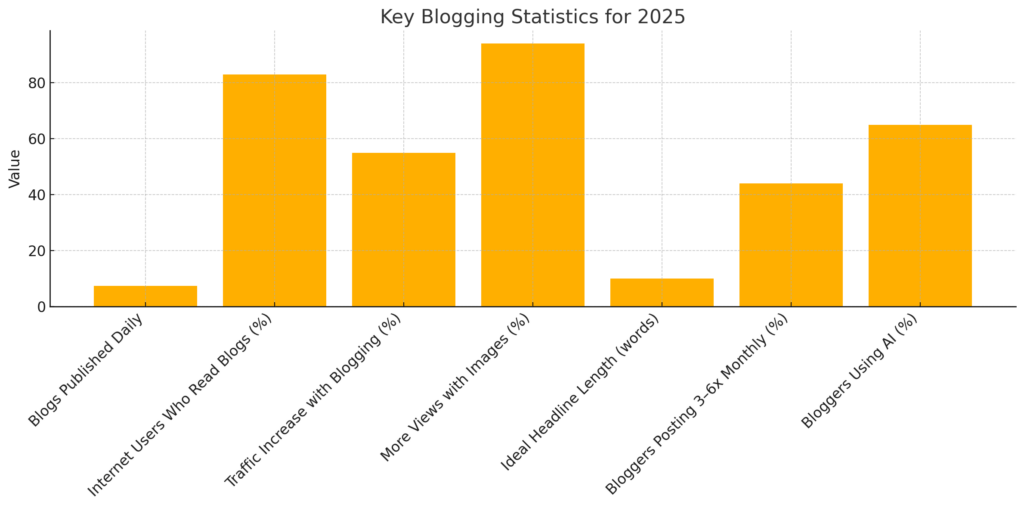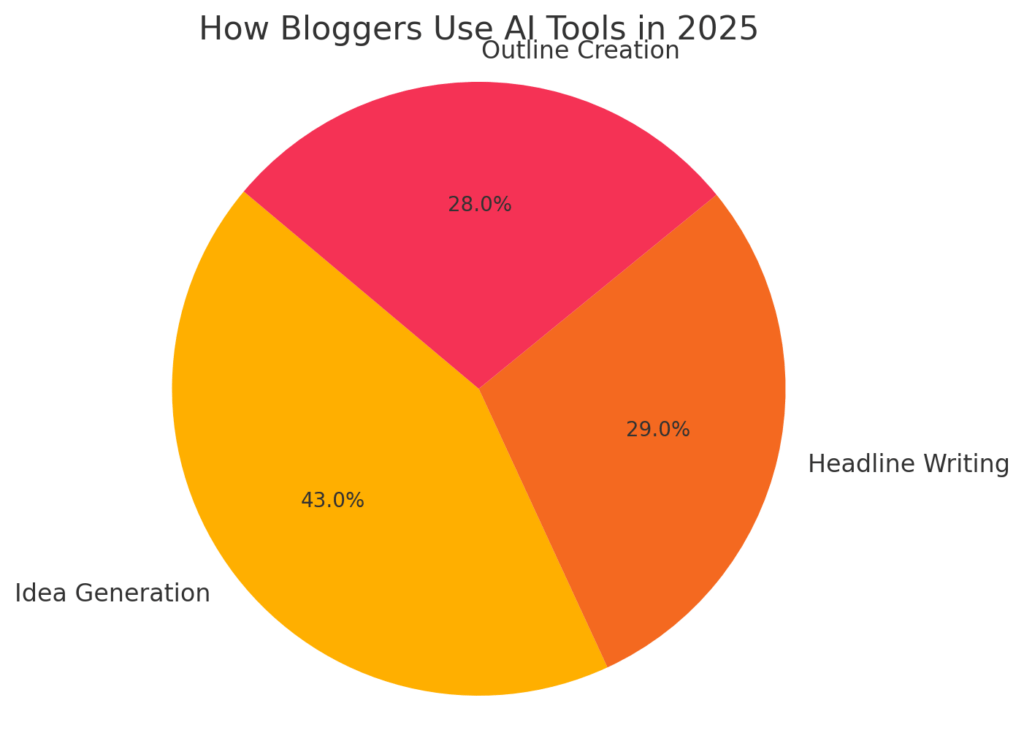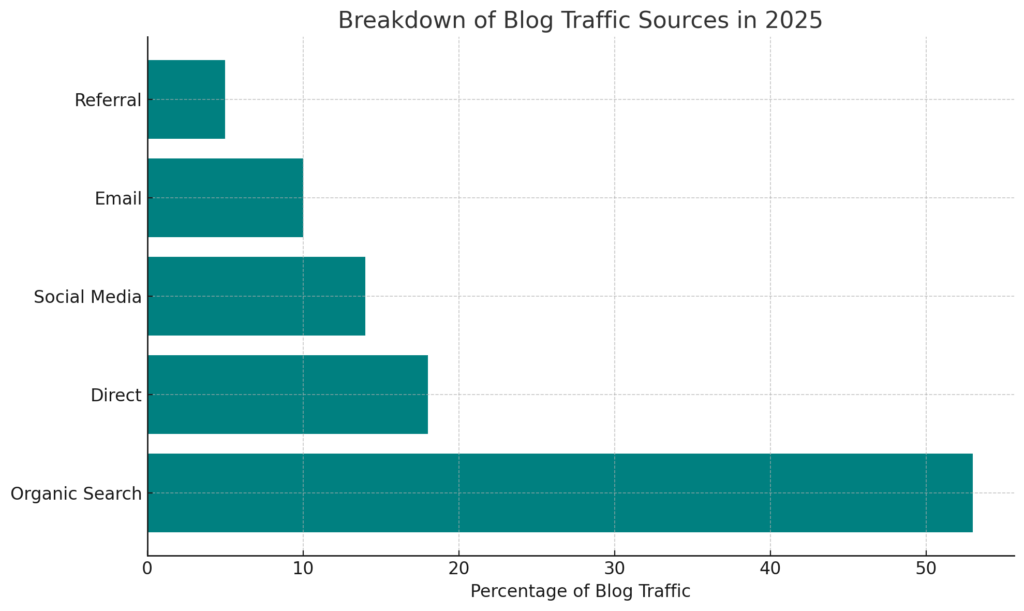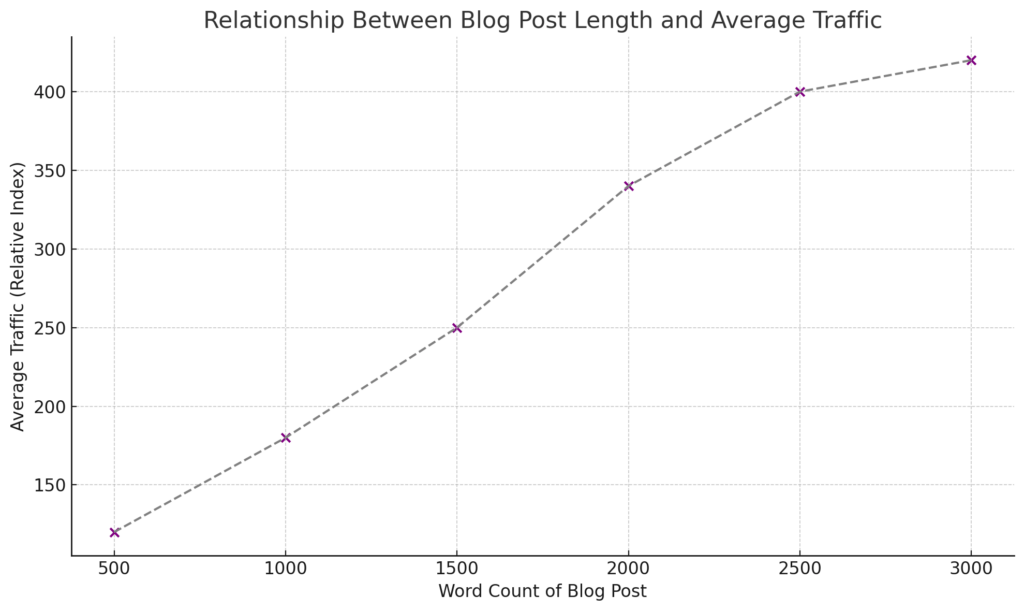
28 Mar BEST BLOG TRAFFIC STATISTICS 2025
Blogging continues to be one of the most reliable, measurable, and adaptable channels in digital marketing. Despite shifts in platform preferences, content formats, and algorithms, blog traffic remains a powerful indicator of brand reach and content performance. From SEO-driven strategies to audience engagement through visuals and video, the landscape is evolving—but not disappearing. In fact, data shows blogging is not just holding steady; it’s becoming more integral to how users search, learn, and make decisions online.
As we head deeper into 2025, understanding the latest blog traffic trends is key to staying ahead. Amra and Elma shares the following statistics to shed light on what’s working now and what will define successful blogging in the near future.
BEST BLOG TRAFFIC STATISTICS 2025 (Editor’s Choice)
Here’s a detailed list of the top 20 best blog traffic statistics covering general trends over time and projected patterns for 2025. These stats highlight the importance of blogging in digital strategy, SEO, and audience engagement.
1. 77% of internet users regularly read blog posts: Blogs remain one of the most consumed content formats globally.
2. Businesses with blogs generate 55% more website visitors: Consistent blogging improves SEO and attracts inbound traffic.
3. Companies that publish 16+ blog posts/month get 3.5x more traffic: Posting frequency has a direct correlation with higher traffic volume.
4. SEO drives over 53% of all blog traffic: Organic search remains the top channel for blog discovery.
5. Google’s algorithm now prioritizes E-E-A-T content in blog rankings: Blogs with clear expertise, experience, authority, and trust rank better in 2025.
6. Long-form blog posts (2,000+ words) receive 3x more traffic and 4x more shares: In-depth content tends to perform better over time.
7. Blog posts with images get 94% more views than text-only posts: Visuals play a major role in improving readability and SEO.
8. Listicles drive 2x more traffic than how-to articles in 2025: Skimmable content is trending, especially among mobile users.
9. 69% of marketers say blogging is more valuable than ever in 2025: Despite social media growth, blogs still drive high-intent traffic.
10. Updating old blog posts boosts traffic by up to 106%: Refreshing evergreen content is an effective 2025 strategy.
11. 67% of B2B buyers read blog content before purchasing: Blogs help establish thought leadership and trust.
12. Blog traffic peaks between 9 a.m. and 11 a.m. on weekdays: Posting schedules still matter in 2025, especially for newsletters and push alerts.
13. Average blog post time on page is 3:15 minutes in 2025: Higher engagement reflects improved formatting and storytelling.
14. 70% of blog traffic comes from mobile in 2025: Responsive design and fast load times are key to retention.
15. Blogs with strong internal linking structure get 40% more organic traffic: Google rewards blogs that keep users navigating through content.
16. Top-performing blog titles have 7–9 words: Clear, concise headlines attract more clicks.
17. User-generated content (e.g., blog comments) increases return visits by 20%: Engaged readers are more likely to revisit and share.
18. Video-embedded blog posts see 83% higher dwell time: Adding video improves time-on-page and boosts search ranking.
19. 50% of all blog traffic in 2025 is from Gen Z and younger Millennials: These groups prefer authenticity, short intros, and punchy takeaways.
20. AI-generated blog content now contributes to 15-20% of total publishing volume: Traffic depends on editing, originality, and tone alignment.

BEST BLOG TRAFFIC STATISTICS 2025 and Future Implications
BEST BLOG TRAFFIC STATISTICS 2025 #1. 77% of internet users regularly read blog posts
Blog reading remains a key online activity, with over three-quarters of internet users engaging in it regularly. This reflects not only a sustained interest in written content but also a need for in-depth, searchable information. As short-form videos dominate social platforms, blogs continue to offer long-form context that other media lack. This statistic signals a strong future for blogging, especially in niche markets where trust and depth are critical. To remain relevant, bloggers and brands should integrate multimedia and offer more personalized content experiences. In 2025 and beyond, user trust in authentic blog voices could outweigh algorithmic content on social media.
BEST BLOG TRAFFIC STATISTICS 2025 #2. Businesses with blogs generate 55% more website visitors
Companies that blog consistently are reaping the benefits in website visibility and traffic. A 55% increase in traffic translates into more potential leads, deeper audience engagement, and higher conversion opportunities. This trend emphasizes that blogging is not just a branding tool but a measurable driver of ROI. For future growth, businesses may lean further into blog-driven content hubs as central SEO assets. With AI tools supporting faster content production, the focus will shift to quality, originality, and real insights. The implication is clear: blogs are a long-term asset in digital strategy.
BEST BLOG TRAFFIC STATISTICS 2025 #3. Companies that publish 16+ blog posts/month get 3.5x more traffic
High-frequency blogging significantly boosts visibility. Brands that commit to publishing 16 or more times a month see over triple the traffic, suggesting that volume can amplify discoverability and brand recall. This may push marketing teams to scale content calendars and automate production while maintaining editorial standards. In 2025, companies that can balance frequency with substance will outperform competitors in organic search. It also highlights the value of content teams skilled in planning and repurposing posts across formats. The future of traffic growth hinges not just on writing more, but writing smarter.
BEST BLOG TRAFFIC STATISTICS 2025 #4. SEO drives over 53% of all blog traffic
Search engine optimization is still the backbone of blog traffic. More than half of readers discover blog content through organic search, underscoring the importance of ranking strategies, keyword research, and on-page optimization. With Google evolving toward semantic and intent-based search, future SEO will require deeper alignment with user needs. Blogs that answer specific questions and offer structured, digestible information will dominate results pages. This makes technical SEO and UX design more integral to content creation than ever. As AI search tools grow, blogs optimized for both human readers and machines will lead.
BEST BLOG TRAFFIC STATISTICS 2025 #5. Google’s algorithm prioritizes E-E-A-T content in blog rankings
Experience, Expertise, Authority, and Trust (E-E-A-T) now define what ranks. Google’s evolving algorithm favors bloggers who demonstrate real-world experience, cite credible sources, and maintain transparent content practices. This shift rewards bloggers and brands that build reputational capital over clickbait. Looking ahead, personal stories, case studies, and firsthand perspectives will gain more traction than generic summaries. Bloggers will need to highlight their credentials and experiences directly in their content. In 2025, search visibility will depend as much on who you are as what you write.

BEST BLOG TRAFFIC STATISTICS 2025 #6. Long-form blog posts (2,000+ words) receive 3x more traffic and 4x more shares
In-depth content performs better across the board. Long-form blogs offer value-rich experiences, keeping readers engaged and more likely to share. This trend reflects a demand for substance in a sea of superficial content. In 2025, content creators may prioritize quality over brevity, especially for SEO-heavy or evergreen topics. While attention spans are short, readers still invest time in content that educates or solves specific problems. As competition rises, thoughtful, long-form posts will be a differentiator in content marketing.
BEST BLOG TRAFFIC STATISTICS 2025 #7. Blog posts with images get 94% more views than text-only posts
Visual content dramatically increases blog engagement. Posts with images are nearly twice as likely to be viewed, making graphics, screenshots, and charts essential components of modern blog design. In the future, the role of visuals will expand to include interactive media, embedded reels, and infographics. Readers process visuals faster than text, which is why blogs that invest in design tend to retain visitors longer. As visual literacy grows, audiences will expect more aesthetically polished content. Visual storytelling isn’t optional—it’s central to future blog strategy.
BEST BLOG TRAFFIC STATISTICS 2025 #8. Listicles drive 2x more traffic than how-to articles in 2025
List-based articles are dominating blog formats in 2025. They’re scannable, quick to digest, and favored by both readers and search engines for their structure. This doesn’t mean how-to content is obsolete, but listicles better match today’s browsing behaviors. Marketers can blend both formats by offering numbered steps within tutorials to boost readability. Future traffic growth will come from clarity and structure, not just originality. As users skim more than they scroll, listicles offer a navigable path through dense information.
BEST BLOG TRAFFIC STATISTICS 2025 #9. 69% of marketers say blogging is more valuable than ever in 2025
Despite the rise of AI and video, the majority of marketers still place high value on blogging. Blogs are seen as anchors for SEO, authority, and evergreen content. Their adaptability allows integration with podcasts, video transcripts, and gated resources. In the future, blogs may serve more as strategy hubs than standalone pieces. Marketers will likely use blog data to inform ad targeting, email campaigns, and product development. The growing value of blogging suggests it will remain foundational even as platforms evolve.
BEST BLOG TRAFFIC STATISTICS 2025 #10. Updating old blog posts boosts traffic by up to 106%
Refreshing existing content is one of the most efficient traffic strategies. By updating keywords, fixing broken links, and improving formatting, old posts can regain visibility and outperform new content. This makes content audits essential for long-term blog health. In 2025, marketers who treat blogs as living documents—not one-off outputs—will maximize returns. With AI making content generation easier, originality will be judged on recency and relevance. The future of blogging involves maintaining content ecosystems, not just producing new posts.

BEST BLOG TRAFFIC STATISTICS 2025 #11. 67% of B2B buyers read blog content before purchasing
Blog content plays a vital role in the B2B buyer journey. With over two-thirds of B2B buyers consulting blogs before making purchasing decisions, the need for high-trust, informative posts is growing. In 2025, decision-makers will rely even more on expert-led insights, detailed comparisons, and solution-focused writing. Businesses targeting B2B audiences will need to prioritize depth and authority in their blog strategy. Blogging won’t just drive awareness—it will directly influence conversions and deal velocity. The blogs that educate, not just sell, will win the loyalty of informed buyers.
BEST BLOG TRAFFIC STATISTICS 2025 #12. Blog traffic peaks between 9 a.m. and 11 a.m. on weekdays
Timing still plays a crucial role in content performance. Blogs published or promoted between 9 a.m. and 11 a.m. tend to receive higher engagement, likely due to workday browsing habits. This insight allows marketers to fine-tune publishing schedules, email pushes, and social shares. In 2025, timing automation and behavioral analytics will become more advanced, allowing even tighter targeting. Blogs that align with user behavior—not just search trends—will see better results. Strategically scheduling content around audience rhythm will remain a low-effort, high-impact tactic.
BEST BLOG TRAFFIC STATISTICS 2025 #13. Average blog post time on page is 3:15 minutes in 2025
Engagement is not just about clicks—it’s about time spent. A 3:15 average time on page shows that readers are still willing to invest attention when content is structured and relevant. This sets a new benchmark for blog quality and reader retention. Marketers will need to monitor content flow, readability, and visual pacing to maintain or exceed this average. In the future, interactivity, embedded media, and scannable layouts will become standard to hold reader focus. Long dwell time will increasingly correlate with stronger SEO rankings and loyalty.
BEST BLOG TRAFFIC STATISTICS 2025 #14. 70% of blog traffic comes from mobile in 2025
Mobile-first is no longer optional—it’s the rule. With 70% of readers accessing blogs via mobile devices, optimization for smaller screens is essential. This affects everything from load speed and font size to content formatting and image compression. Blogs that ignore mobile usability risk losing the majority of their audience before they even begin reading. As voice search and AI chat interfaces grow, mobile-optimized, question-focused blogs will perform best. The brands that prioritize responsive design and frictionless UX will see stronger retention and conversion rates.
BEST BLOG TRAFFIC STATISTICS 2025 #15. Blogs with strong internal linking structure get 40% more organic traffic
Internal linking is a quiet but powerful traffic driver. Blogs that guide readers to related content not only keep them on site longer but also signal topic authority to search engines. A 40% traffic boost can come from thoughtful content clustering and strategic anchor text. In 2025, internal linking will be driven by real-time analytics and AI-assisted navigation tools. This makes content planning and categorization critical to scaling organic performance. A well-linked blog behaves like a content library, offering discovery paths that deepen engagement.

BEST BLOG TRAFFIC STATISTICS 2025 #16. Top-performing blog titles have 7–9 words
Headline length matters more than most realize. Blog titles with 7 to 9 words strike the ideal balance between clarity and curiosity, improving both click-through rates and SEO. As AI tools generate more headlines, crafting standout titles will become a competitive edge. In the future, A/B testing titles across platforms will become a standard practice. Writers will need to pair keyword alignment with emotional hooks and reader intent. The blogs that get seen will be those with titles worth pausing on.
BEST BLOG TRAFFIC STATISTICS 2025 #17. User-generated content increases return visits by 20%
Comments, reviews, and community contributions drive meaningful engagement. Blogs that allow users to participate—whether through discussion, feedback, or submissions—see stronger return traffic. In 2025, user interaction will extend to polls, embedded replies, and AI-assisted comment highlights. This shift will position blogs as two-way platforms rather than publishing endpoints. Brands that invite conversation will build stronger connections and organic amplification. Return visits powered by participation will become a top metric for content success.
BEST BLOG TRAFFIC STATISTICS 2025 #18. Video-embedded blog posts see 83% higher dwell time
Embedding video significantly boosts time-on-page metrics. Blogs that integrate short explainers, tutorials, or commentary clips keep readers engaged longer. In 2025, hybrid content that blends text, video, and even AI-generated voiceovers will dominate engagement benchmarks. Marketers will prioritize media-rich pages to strengthen SEO and improve retention. The ability to learn or absorb content visually adds another layer of accessibility. As attention becomes more fragmented, video will act as a glue that holds users in the experience.
BEST BLOG TRAFFIC STATISTICS 2025 #19. 50% of all blog traffic in 2025 is from Gen Z and younger Millennials
Younger generations now make up half of all blog readership. Gen Z and younger Millennials are mobile-first, value-driven, and quick to dismiss content that feels inauthentic. Blogs targeting this demographic will need to match their tone, format expectations, and cultural fluency. In the future, blogs that are conversational, meme-aware, and purpose-led will gain faster traction. These readers also favor transparency—behind-the-scenes posts, values-driven storytelling, and human voices. Brands that speak with them, not at them, will thrive in the blog landscape.
BEST BLOG TRAFFIC STATISTICS 2025 #20. AI-generated blog content contributes to 15-20% of total publishing volume
AI-generated content is becoming a larger part of the blog ecosystem. While it enables scale, it also raises the bar for originality and human nuance. In 2025, readers and search engines will increasingly favor content that blends AI efficiency with human oversight and storytelling. Editors will play a crucial role in refining tone, verifying facts, and aligning with brand voice. Blogs that use AI as a collaborator—not a replacement—will produce higher-impact content. The next era of blogging will be co-written: machines provide the draft, humans make it matter.
Where Blog Strategy Goes From Here
As content formats diversify and AI accelerates production cycles, the fundamentals of successful blogging remain grounded in relevance, clarity, and trust. The stats outlined above show that high-performing blogs are no longer about quantity alone—they’re about aligning with user intent, leveraging multimedia, and continuously improving existing content. From Gen Z engagement to mobile optimization and internal linking, every detail contributes to visibility and reader loyalty. Looking forward, blogs will evolve into dynamic content ecosystems: searchable, scannable, and personalized. The marketers and creators who adapt to this integrated, user-first model will lead the next era of digital communication. Now is the time to rethink blog strategy not as static publishing—but as a long-term, evolving experience.
Sources:
- https://www.demandmetric.com/content/content-marketing-infographic
- https://www.hubspot.com/marketing-statistics
- https://blog.hubspot.com/marketing/blogging-frequency-benchmarks
- https://www.brightedge.com/resources/webinars/seo-channel
- https://developers.google.com/search/blog/2022/12/introducing-e-e-a-t
- https://www.semrush.com/blog/long-form-content/
- https://www.mdgadvertising.com/marketing-insights/marketing-strategy/its-all-about-the-images-infographic/
- https://buzzsumo.com/blog/list-posts/
- https://contentmarketinginstitute.com/articles/content-marketing-trends-2024/
- https://blog.hubspot.com/marketing/update-old-blog-posts
- https://www.demandgenreport.com/resources/reports/2023-content-preferences-survey-report/
- https://www.orbitmedia.com/blog/blogging-statistics/
- https://databox.com/average-time-on-page
- https://www.statista.com/statistics/277125/share-of-website-traffic-coming-from-mobile-devices/
- https://ahrefs.com/blog/internal-linking/
- https://backlinko.com/headline-statistics
- https://neilpatel.com/blog/ugc-benefits/
- https://wistia.com/learn/marketing/video-increase-time-on-page
- https://www.gwi.com/reports/gen-z-and-millennials-digital-behavior
- https://www.semrush.com/lp/state-of-content-marketing/

